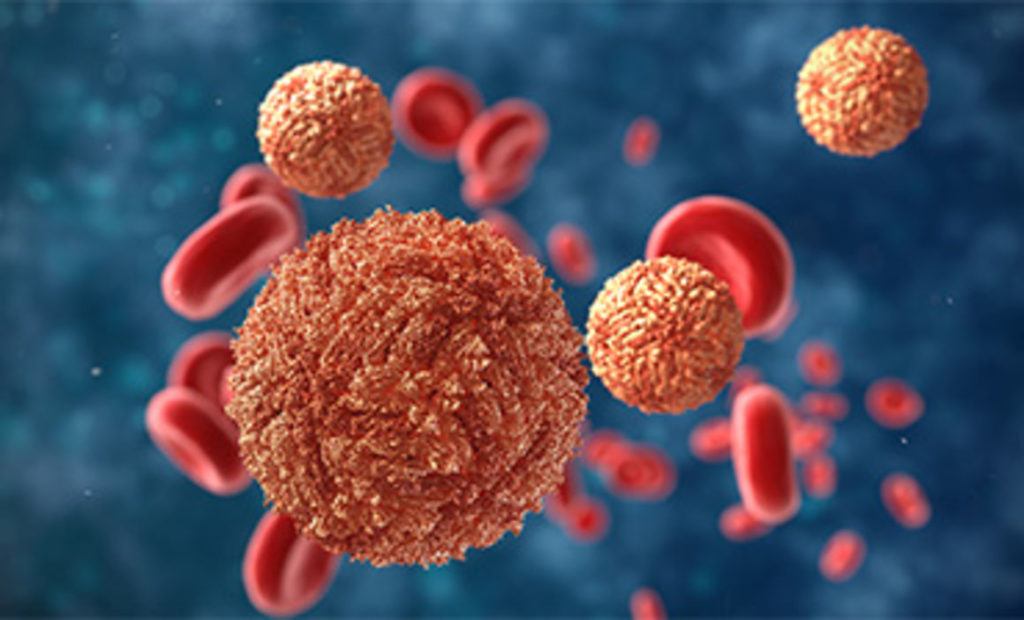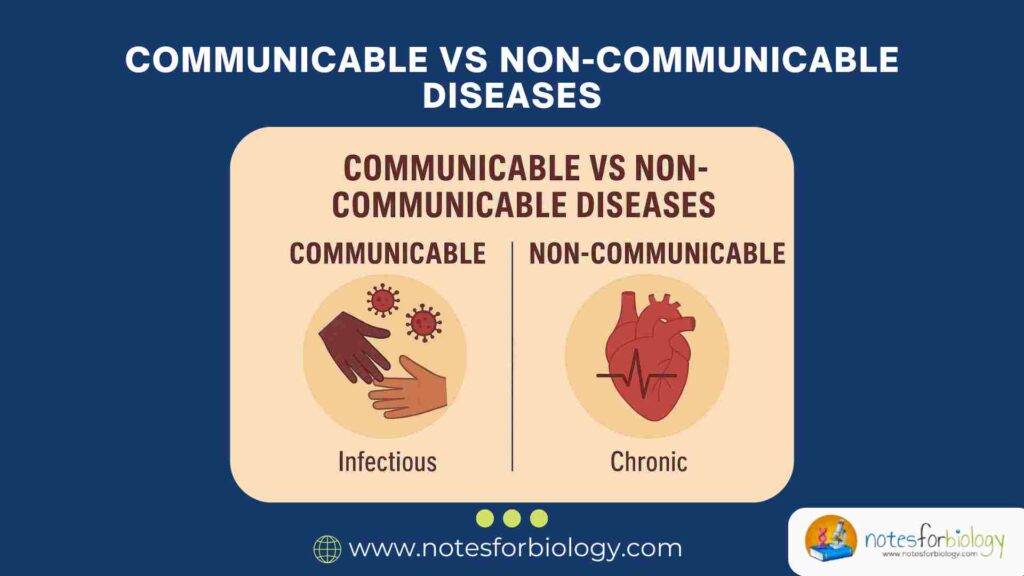In the field of public health and clinical medicine, distinguishing between communicable and non-communicable diseases is essential for effective diagnosis, treatment, and prevention. These two major categories of diseases differ in terms of causes, spread, management, and societal impacts.
Understanding the characteristics of these disease groups helps healthcare professionals and policymakers develop appropriate health strategies, control outbreaks, and improve population health outcomes.
Table of Contents
Importance of Distinguishing Between Communicable and Non-communicable Diseases
Proper classification of diseases allows for targeted public health interventions, efficient resource allocation, and customized patient care. Recognizing whether a disease is infectious or chronic also aids in determining risk factors, modes of transmission, and preventive actions.
This classification is particularly important in managing global health challenges, where some regions battle communicable disease outbreaks while others contend with a rise in lifestyle-related non-communicable conditions.
Global Health Implications and Relevance
Both communicable and non-communicable diseases contribute significantly to global mortality and morbidity. While communicable diseases remain a leading cause of death in developing countries, non-communicable diseases are increasing rapidly worldwide due to aging populations and changing lifestyles.
Addressing these dual health burdens requires integrated global health policies, emphasizing both infection control and chronic disease management.
What are Communicable Diseases?
Communicable diseases, often called infectious diseases, are illnesses caused by pathogenic microorganisms that can be transmitted from one person to another or from animals to humans.
These diseases can spread rapidly, causing local outbreaks, epidemics, or even global pandemics, making their control a priority for public health authorities.
Definition of Communicable Diseases
It is any disease that is spread through direct or indirect contact with an infected individual, vector, or contaminated surface. It involves infectious agents such as bacteria, viruses, fungi, or parasites.
The capacity of these diseases to move from one host to another distinguishes them from non-infectious conditions and necessitates specific control measures like isolation, vaccination, and public education.
How Communicable Diseases are Transmitted
Transmission can occur through several routes: direct physical contact, droplets from coughing or sneezing, contaminated food or water, insect bites, or contact with contaminated objects. Some diseases, like HIV/AIDS, also spread through blood transfusions or sexual contact.
Understanding transmission routes is key to breaking the chain of infection and preventing disease spread in communities.
Common Examples of Communicable Diseases
Familiar examples of them include tuberculosis, influenza, COVID-19, malaria, cholera, hepatitis B, measles, and HIV/AIDS. Each of these diseases has specific transmission pathways and control strategies.
These diseases can vary in severity, ranging from mild infections like the common cold to life-threatening conditions such as Ebola virus disease.
What are Non-communicable Diseases (NCDs)?
Non-communicable diseases (NCDs) are medical conditions that are not caused by infectious agents and cannot be transmitted from person to person. They typically develop slowly and progress over time, often resulting in long-term health complications.
NCDs are increasingly recognized as a leading cause of death globally, particularly in middle- and high-income countries.
Definition of Non-communicable Diseases
A non-communicable disease is a health condition that arises due to genetic, physiological, environmental, and behavioral factors rather than an infection. These diseases tend to be chronic, requiring ongoing management rather than a one-time cure.
Their prevention relies on managing risk factors like diet, exercise, and exposure to harmful substances rather than avoiding contact with infected individuals.
How NCDs Develop and Progress
Non-communicable diseases usually develop gradually, influenced by genetic susceptibility and environmental exposures. Poor lifestyle choices such as unhealthy diets, lack of physical activity, tobacco use, and excessive alcohol consumption are major contributors.
If not detected early, NCDs can progress silently and cause severe organ damage or life-threatening complications like heart attacks, strokes, and cancers.
Common Examples of Non-communicable Diseases
Examples of NCDs include diabetes mellitus, cardiovascular diseases, chronic respiratory diseases, cancer, osteoporosis, and mental health disorders. These conditions often require lifelong monitoring, lifestyle modifications, and pharmacological interventions.
17 Key Differences Between Communicable and Non-communicable Diseases
This section highlights crucial differences that separate communicable and non-communicable diseases based on their causes, progression, prevention, and health impacts.
Understanding these distinctions is essential for healthcare professionals, public health authorities, and policymakers in addressing both infectious disease outbreaks and chronic health conditions effectively.
1. Definition
- Communicable diseases are caused by infectious agents and transmitted between hosts.
- Non-communicable diseases are non-infectious and result from genetic, lifestyle, or environmental factors.
2. Mode of Transmission
- Communicable diseases spread through direct or indirect contact.
- Non-communicable diseases do not transmit between individuals.
3. Causative Agents
- Communicable diseases involve bacteria, viruses, fungi, or parasites.
- Non-communicable diseases are caused by genetic mutations, lifestyle choices, and environmental exposures.
4. Incubation Period
- Communicable diseases typically have a defined incubation period.
- Non-communicable diseases develop slowly over years.
5. Duration of Disease
- Many communicable diseases are acute or sub-acute.
- Non-communicable diseases are often chronic and lifelong.
6. Prevention Methods
- Preventing communicable diseases involves vaccination, sanitation, and isolation.
- Preventing NCDs requires lifestyle modifications, healthy diets, and regular health screenings.
7. Control Strategies
- Communicable diseases are controlled via public health surveillance and outbreak management.
- NCDs require long-term monitoring and risk factor management.
8. Global Disease Burden
- Communicable diseases dominate in low-income countries.
- NCDs are the primary health burden in high-income and transitioning nations.
9. Treatment Approaches
- Communicable diseases often respond to antimicrobials or antivirals.
- NCDs require chronic disease management, including medication and lifestyle adjustments.
10. Role of Vaccination
- Vaccines play a critical role in preventing communicable diseases.
- No vaccines exist for most NCDs, though some cancers (e.g., cervical cancer via HPV vaccine) can be prevented.
11. Impact on Public Health Systems
- Communicable disease outbreaks strain emergency healthcare resources.
- NCDs increase long-term healthcare costs and burden hospital systems over decades.
12. Complications and Mortality Rates
- Some communicable diseases cause rapid complications and fatalities.
- NCDs result in progressive, long-term morbidity and are responsible for 70% of global deaths.
13. Occurrence and Spread Patterns
- Communicable diseases often occur as outbreaks or epidemics.
- NCDs show steady, gradual increases, typically linked to aging and lifestyle trends.
14. Influence of Lifestyle Factors
- Lifestyle has limited impact on communicable disease risk.
- NCDs are heavily influenced by diet, physical activity, smoking, and alcohol use.
15. Role of Environment
- Environmental sanitation plays a large role in communicable disease control.
- Environmental factors like air pollution contribute to NCD prevalence.
16. Recurrence Possibility
- Communicable diseases may recur due to reinfection.
- NCDs persist chronically but can relapse or worsen without proper control.
17. Socioeconomic Impacts
- Communicable diseases reduce workforce productivity during outbreaks.
- NCDs impose long-term economic burdens due to lifelong treatment needs.
Importance of Disease Classification
Categorizing diseases into communicable and non-communicable types improves diagnosis, surveillance, and treatment strategies. It ensures healthcare systems can prioritize resources and develop appropriate prevention programs.
Differentiating disease types also enhances public health education, enabling communities to adopt measures suited to controlling specific health risks.
Why Distinguishing Disease Types Matters in Medicine
Accurate classification informs patient care protocols, hospital infection control policies, and chronic disease management programs. It ensures early detection of outbreaks and timely response to chronic disease trends.
Health Policy and Prevention Strategies
Health authorities use disease classification to design prevention campaigns, immunization schedules, health check-up programs, and community interventions targeting high-risk populations.
Global Statistics and Data
Health data reveals the shifting patterns of global disease burdens. While communicable diseases have declined in many countries, NCDs are rapidly increasing due to urbanization, changing diets, and sedentary lifestyles.
Prevalence of Communicable Diseases Worldwide
Communicable diseases remain leading causes of death in sub-Saharan Africa and Southeast Asia, with diseases like tuberculosis, HIV/AIDS, and malaria claiming millions of lives annually.
Global Burden of Non-communicable Diseases
NCDs account for over 70% of global deaths, with heart disease, cancer, diabetes, and chronic respiratory diseases leading the toll. The World Health Organization reports a sharp rise in these diseases in middle-income nations.
Prevention and Control Measures
Disease control involves both immediate interventions for infectious diseases and long-term risk management for chronic conditions.
Public Health Measures for Communicable Diseases
Strategies include vaccination, outbreak surveillance, safe water access, vector control, and public education on hygiene and infection prevention.
Lifestyle Changes and Early Detection for NCDs
Prevention focuses on balanced nutrition, regular exercise, avoiding tobacco and alcohol, stress management, and early screening for at-risk individuals.
Role of International Health Organizations
Global organizations coordinate responses to health threats, set medical guidelines, and fund disease control programs in under-resourced regions.
WHO’s Strategies on Communicable and NCDs
The World Health Organization leads vaccination drives, disease elimination campaigns, and chronic disease management initiatives, aiming to reduce premature mortality rates.
Global Health Campaigns and Programs
International efforts like World AIDS Day, World No Tobacco Day, and campaigns against COVID-19 or polio have raised awareness and improved public health outcomes globally.
Recent Trends in Disease Patterns
Emerging and re-emerging infections, along with a rapid increase in NCD rates, have created complex public health challenges requiring coordinated responses.
Emerging Communicable Diseases (e.g., COVID-19)
New infectious diseases like COVID-19, Zika virus, and Ebola highlight the need for global surveillance, research funding, and healthcare preparedness.



Rising Non-communicable Disease Rates Globally
As populations age and lifestyles become more sedentary, NCD rates are climbing, even in low- and middle-income countries, adding pressure to healthcare systems.
Conclusion
Both communicable and non-communicable diseases significantly impact global health. Understanding their differences enables effective prevention, treatment, and control strategies.
By promoting public awareness, enhancing healthcare access, and encouraging healthy behaviors, societies can manage disease burdens and improve quality of life.
Frequently Asked Questions (FAQ)
What are the top three communicable diseases globally?
Tuberculosis, HIV/AIDS, and respiratory infections (like pneumonia) are the top three communicable diseases worldwide.
Which lifestyle factors increase the risk of non-communicable diseases?
Poor diet, physical inactivity, tobacco use, and excessive alcohol consumption are major lifestyle factors that raise non-communicable disease risk.
Can communicable diseases become chronic?
Yes, some communicable diseases like HIV, hepatitis B, and tuberculosis can become chronic if not effectively treated.
Related Contents
Bloodstream Infections (BSIs) and Common Pathogenic Bacteria in the Blood




